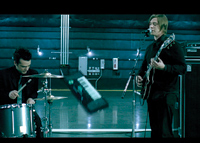Sunset Edit currently offlines on Avid Media Composer Meridien systems and onlines on Avid Symphony. The new move will bring equipment upgrades. They will use Avid Adrenalines for offline, and as of press time, they were still investigating online systems.
THE TIME FACTOR

Recent Sunset Edit projects include videos for Jet, Eminem and Interpol. They use Avid gear for editing.
|
Most editors at London's Cut & Run - they also have a Los Angeles-based studio and will be opening another in New York City in January - balance music videos and spots.
"You can get away with a lot more in videos than in commercials," says LA-based editor Jeff Grippe. "You have more time to tell a story and you're not stuck with a bunch of rules. With a commercial you have X amount of seconds for this and that. Videos are more free form, and it's a nice creative break [from spots]."
While the money isn't even close to that of commercial work, that does not dissuade these editors from video work. "I never care about how much I get paid," says Cut & Run (www.cutandrun.tv/) editor Dayn Williams in London. "I care about how much time I get, because these days it's always less time and I don't feel I can do my best work. On the Low Frequency Oscillation [LFO] Freak video I asked John [Glover, a fellow editor] to help me because there was so little time."

Threshold recently cut this Mis-Teeq Scandalous video, which was shot guerrilla-style.
|
The video earned them a UK-based CADS Music Vision Award. "There was a lot of mathematics involved as far as frame cutting, and we had to work out the mechanics of it with a lot of intricate compositing that was very time consuming."
"Here in Europe, a song won't get commissioned until it reaches a certain point in the charts, but once it does, it's a rush to get it on the air," says Glover.
Williams and Glover note that European videos are more about storytelling and experimentation while American videos are more focused on glamour and performance.

Cut + Run's this 50 Cent video for In Da Club.
|
"There's definitely different boundaries as far as what can be aired in Europe versus the US," says Williams. "In the European market you're more likely to pick up edgier stuff. America's style is more pop and mainstream."
Despite the low pay and long hours, videos can lead to financial and personal reward as they quickly garner recognition and thus bolster the reputation of artists.
"Videos definitely get a lot of attention, both in the video and commercial worlds," says Williams. "In this business it's word of mouth that gets you the opportunity to escalate your career, and videos are good at doing that. It's less so with commercials because videos last longer on air. Since John and I won this award, we're the editors of the moment, and offers are pouring through the door."

Jeff Grippe
|
Cut + Run editors work on Avid NLEs.
REACHING THE THRESHOLD
LA's Threshold Sound + Vision (www.thresholdsound.com/) was formed in '01 by the core group of artists who were working in the video department of Sony Music Studios West. They have taken that same approach to providing A/V services to the labels as when they were at Sony Music. Today they work on videos, concerts and longform music-based programming.
"We do anything audio/video post," says co-owner Marc Schrobilgen. "We also offer mixing, album mastering and restoration, manufacturing, CD/DVD replication, and we have a production arm where we'll shoot content."
Threshold opened just as the music business was turning sharply downward. This could have crippled other newly-formed companies but Threshold was poised to capitalize on this more fiscally-conservative market. "Sometimes we shoot and edit and do everything," says Schrobilgen. "When budgets were coming down, everyone was looking for low-cost solutions to do music videos, so people were just capturing live concerts and making videos. We did a number of those. Because of the budgets, the label will just shoot a band guerrilla-style and see what we can do with it. We did that with Mis-Teeq's Scandalous video."
This all-in-one approach has allowed Threshold to work entirely in the music world and make a profit. "We fancy ourselves a soup-to-nuts shop," says Schrobilgen. "That's a way to get around the economics of music videos. If we're involved from the beginning, there's definitely a way to make money. It's a combination of efficiency and expertise. Providing a lot of services allows you to control your costs more, and if you run over in one area you know you control what happens next so you can balance out your time and budget."
Threshold uses Avid tools for editing.
EFFICIENCY RULES
LA's Moneyshots (www.moneyshots.com/) has worked on some groundbreaking videos since opening three years, including one from Missy Elliot, as well as Outkast's Hey Ya, which earned them the MTV Music Video Award for Best Visual Effects. Co-owner Elad Offer echoes his peers when he says, the video market is becoming more difficult to successfully participate in these days.
"The unfortunate situation is that budgets have dropped considerably over the last three years so we had to divert some of our attention to commercials," he explains. "Videos allow you a level of creativity and playfulness that commercials don't, so we like to stay in that market; we're just more selective now about what projects we'll do."
One would think though that with so many big-budget videos to their credit list, Moneyshots would be one of the few companies thriving with this work, but that's not the case. "Usually the bigger the project the less money you make on it," says Offer. "Surprisingly enough it's the smaller jobs that have a limited amount of work where we can make a profit."
Still, if you are committed and careful, you can make money on videos, says Offer. "With videos, it's a matter of being very efficient. You have no dead time at all - machines work around the clock, and many times people work around the clock. It's a matter of not wasting any time or any money where you don't have to. For us it's been about keeping a relatively bare bones staff here when we don't need the manpower. We have a family of freelancers. Plus you try and make your money in other places." Moneyshots uses Alias Maya and Discreet Flame for its effects work.